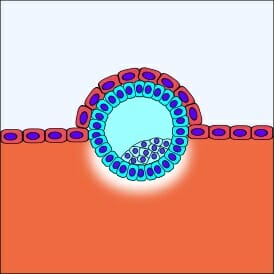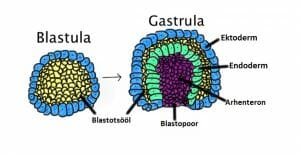Embryo Definition
An embryo refers to the early developmental stage of eukaryotic organisms following the fertilization of an egg (derived from a female) by sperm (derived from a male) as a method of sexual reproduction. In animals, the initial diploid cell that results from the fusion of the egg and the sperm contains half the genetic information (DNA) from each of the parental cells and is termed a zygote. As the zygote begins to divide by mitosis, the early multicellular organism is termed an embryo. In humans, the embryonic stage of development is defined as the period from week 5 to week 11 of gestation. After this stage, the embryo transitions into a fetus. In plants, the process of embryogenesis extends from the time of fertilization until dormancy.
Stages of Mammalian Embryonic Development
Although there are some inherent differences between species, the embryos of most vertebrate species involve the same processes during embryogenesis. Most of the notable differences tend to become more apparent during the later stages of development. In mammals, embryogenesis proceeds in the following distinct stages:
Cleavage
Following fertilization, the zygote begins to divide by mitosis in a manner in which there is a lack of growth, and the resulting cluster of cells remains the same size as the initial fertilized cell (shown below). After four rounds of cleavage, the 16-celled cluster is termed the morula. The cells comprising the morula eventually form an outer layer called the trophoblast and an inner cluster of cells, termed the inner cell mass, which will form the embryo. Fluid will then fill the space between the trophoblast and the inner cells, with the two cell formations connecting at one pole, termed the embryonic pole.
Blastula Stage
After seven rounds of cleavage, the cell cluster comprised of 128 cells is known as the blastula. The blastula is characterized by a circular layer of cells termed the blastoderm surrounding an inner cell mass termed the blastocyst (shown below). The fluid-filled cavity residing between the two groups of cells is termed the blastocoel. During this stage, the trophoblast as described above is divided into an outer layer called the syncytiotrophoblast and an inner layer termed the cytotrophoblast. These layers do not form the embryo, but will eventually help form the placenta. The inner cluster of cells, termed the inner cell mass, also begins to undergo organization during this stage. At the center of the inner cell mass is a layer of flat, differentiated cells termed the endoderm. The endoderm forms the yolk sac which will supply the growing embryo with nutrients and a source of blood supply until the formation of the placenta is complete. Between the remaining cells, the amniotic cavity is formed, the bottom of which is composed of prismatic cells called the ectoderm, and forms a structure called the embryonic disk. The embryonic disk then begins to change conformation and forms a pore with the yolk sac. The cells of the ectoderm gradually descend to meet the endoderm. A third layer of cells is also formed and is situated laterally between the endoderm and ectoderm. These layers are termed the germ layers and will eventually form the various tissues of the organism. It is also during this stage that implantation of the embryo into the uterine wall occurs.
Gastrula Stage
Once the three germ layers have been formed and move towards the center of the blastula, the embryo is called a gastrula (shown below). Although the differentiation of the various cell types occurs during the blastula stage, the organization of the cell into three distinct layers is known as gastrulation. Gastrulation typically occurs during the third week of pregnancy, and the process begins with the formation of a thick structure along the midline of the embryonic disk, termed the primitive streak. The primitive streak defines the major axes of the embryo (left, right, cranial, and caudal sides). At the cranial end of the embryonic disk, the primitive streak expands to form a primitive node and begins to extend along the midline to the caudal end and to form a primitive groove. At this point, the outer layer of cells begins to fold inward and detach along the primitive streak via a process termed invagination. The first cells which move inward displace the outer layer of cells and are replaced by a new cell layer termed the definitive endoderm. Inside the embryo, the cells that were internalized join and form the definitive ectoderm. The group of cells residing between the definitive ectoderm and endoderm form the definitive mesoderm.
Organogenesis Stage
Once the various germ layers have been formed, each begins to differentiate into tissues and organs within the developing embryo, known as organogenesis. The ectoderm will differentiate into the neural tube which forms the central nervous system, neural crest which forms the peripheral nervous system, and epidermis will form the skin, hair, inner ear, eyes, and mouth. The ectoderm also forms the facial cartilage, tooth dentin, sebaceous glands, and melanocytes. The mesoderm will result in the formation of the kidneys, muscles, gonads, bones, red blood cells, and the circulatory system. The endoderm will form the lungs, bladder, thyroid, and pancreas. The heart is the first organ to develop, which typically occurs after gastrulation, just after the third week of pregnancy. The various processes of organogenesis and cellular differentiation continues until 11 weeks of pregnancy. After this point, the embryo becomes a fetus.
Plant Embryonic Development
Similar to animals, plant embryogenesis occurs as the result of sexual reproduction via the fertilization of the ovule via pollination. The resulting diploid zygote is accompanied by an endosperm, which together form the seed (shown below). The endosperm consists of dense nutrients which will supply the growing embryo. After undergoing asymmetrical cell division, a small apical cell, which forms the embryo, and a larger basal cell which supplies nutrients to the embryo via the endosperm are formed. At the eight-cell stage, the embryo begins to flatten, forming the axis of the structures which will eventually form the shoot meristem, cotyledons, hypocotyl, roots, and root meristem. In plants, the embryonic stage ends with germination, when the plant begins to grow out of the seed. At this stage, the plant is termed a plantling. The specific processes involved in plant embryogenesis differ depending on the species of plant.
Quiz
1. The ________ in mammals and _________ in plants supply the growing embryo with nutrients.
A. Yolk sac, endoderm
B. Endosperm, embryonic sac
C. Yolk sac, endosperm
D. Endoderm, endosperm
2. In humans, the embryonic period lasts until ________. In plants, the embryonic period lasts until ________.
A. 14 weeks, until the roots are formed
B. 11 weeks, until germination
C. 14 weeks, until the seed is formed
D. 11 weeks, until the roots are formed
3. The primitive streak is important because:
A. It provides a site of attachment for the placenta.
B. It supplies the growing embryo with nutrients.
C. It will form the roots of the plant.
D. It defines the major axes of the embryo and is involved in gastrulation.
4. The process during which the three germ layers are formed is termed:
A. Gastrulation
B. Blastulogenesis
C. Gastrogenesis
D. Organogenesis
References
- Beetschen JC. (2001). Amphibian gastrulation: history and evolution of a 125 year-old concept. Int J Dev Biol. 45(7):771-95.
- Cooke J. (1985). Early specification for body position in mes-endodermal regions of an amphibian embryo. Cell Differ. 17(1):1-12.
- Eyal-Giladi H. (1984). The gradual establishment of cell commitments during the early stages of chick development. Cell Differ. 14(4):245-55.
- Gilbert SF. (2000). Developmental Biology. 6th edition. Sinauer Associates; Sunderland (MA).
- Rubarth L and Van Woudenberg CD. (2016). Development of the Gastrointestinal System: An Embryonic and Fetal Review. Neonatal Netw. 35(3):156-8.
- Thisse B and Thisse C. (2015). Formation of the vertebrate embryo: Moving beyond the Spemann organizer. Semin Cell Dev Biol. 42:94-102.
- Warga RM and Stainier DY. (2002). The guts of endoderm formation. Results Probl Cell Differ. 40: 28-47.
- Wolpert L. (1992). Gastrulation and the evolution of development. Dev Suppl. 7-13.
Embryo




No comments:
Post a Comment